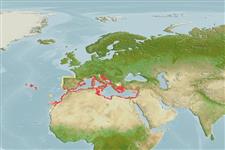Elasmobranchi (squali e razze) (sharks and rays) >
Carcharhiniformes (Ground sharks) >
Triakidae (Houndsharks) > Triakinae
Etymology: Mustelus: Latin for weasel, an ancient name for sharks, possibly referring to the pointed snouts, swift movements and/or rapacious feeding behavior of smaller predatory sharks [strictly not tautonymous with Squalus mustelus Linnaeus 1758 since type was designated by the ICZN] (See ETYFish); punctulatus: Diminutive of punctum (L.), spot, i.e., having tiny spots, referring to small black spots often present on body (See ETYFish).
More on author: Risso.
Environment: milieu / climate zone / distribuzione batimetrica / distribution range
Ecologia
marino demersale. Subtropical; 45°N - 20°N
Eastern Atlantic: Mediterranean to Western Sahara. Confused with Mustelus mustelus and most data for this species were in part attributable to Mustelus mediterraneus.
Length at first maturity / Size / Peso / Age
Maturità: Lm 95.0, range 60 - 100 cm
Max length : 190 cm TL maschio/sesso non determinato; (Ref. ); common length : 120 cm TL maschio/sesso non determinato; (Ref. )
An inshore, continental bottom-dwelling shark. Probably a crustacean feeder. Presumably viviparous.
Life cycle and mating behavior
Maturità | Riproduzione | Deposizione | Uova | Fecundity | Larve
Probably viviparous (Ref. 244). Distinct pairing with embrace (Ref. 205).
Compagno, L.J.V., 1984. FAO Species Catalogue. Vol. 4. Sharks of the world. An annotated and illustrated catalogue of shark species known to date. Part 2 - Carcharhiniformes. FAO Fish. Synop. 125(4/2):251-655. Rome: FAO. (Ref. 244)
IUCN Red List Status (Ref. 130435: Version 2025-1)
Threat to humans
Harmless
Human uses
Pesca: commerciale
Strumenti
Special reports
Download XML
Fonti Internet
Estimates based on models
Preferred temperature (Fonte Biblio.
123201): 15.3 - 21.6, mean 18.8 °C (based on 182 cells).
Phylogenetic diversity index (Fonte Biblio.
82804): PD
50 = 0.5000 [Uniqueness, from 0.5 = low to 2.0 = high].
Bayesian length-weight: a=0.00355 (0.00223 - 0.00565), b=3.16 (3.03 - 3.29), in cm total length, based on LWR estimates for this species & Genus-body shape (Ref.
93245).
Trophic level (Fonte Biblio.
69278): 3.8 ±0.4 se; based on diet studies.
Generation time: 3.3 ( na - na) years. Estimated as median ln(3)/K based on 1
growth studies.
Resilienza (Fonte Biblio.
120179): Basso, tempo minimo di raddoppiamento della popolazione 4.5 - 14 anni (tm=1.3-2.6(?); Fecundity is presumably low like other Mustelus species).
Fishing Vulnerability (Ref.
59153): Moderate to high vulnerability (51 of 100).
🛈
Nutrients (Ref.
124155): Calcium = 15.9 [4.3, 80.9] mg/100g; Iron = 0.485 [0.153, 1.866] mg/100g; Protein = 22.1 [19.7, 24.4] %; Omega3 = 0.144 [0.057, 0.357] g/100g; Selenium = 54.4 [14.4, 196.5] μg/100g; VitaminA = 3.8 [1.2, 12.1] μg/100g; Zinc = 0.461 [0.202, 0.945] mg/100g (wet weight);
